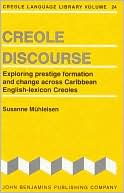

 |

|

The average rating for Creole Discourse: Exploring Prestige Formation and Change across Caribbean English-Lexicon Creoles based on 2 reviews is 3 stars.
Review # 1 was written on 2013-06-27 00:00:00 Paul Lopez Paul LopezTHE SINO-TIBETAN LANGUAGES, edited by Graham Thurgood and Randy J. LaPolla, is part of the Routledge Language Family Series. Like all volumes, this one contains mainly synchronic descriptions of all the languages in a recognized family, with some extra chapters on the family as a whole and writing systems. While I am trained in linguistics, my own research focuses on the the Indo-European, Finno-Ugrian/Uralic, and Turkic languages. I read THE SINO-TIBETAN LANGUAGES only for pleasure, and so my review will attempt to merely describe it rather than critique it. The chapters on the family in general are three. Graham Thurgood contributes "A subgrouping of the Sino-Tibetan languages", where he describes the interaction between language contact, change, and inheritance. From Randy J. LaPolla we have an "Overview of Sino-Tibetan Morphosyntax", which lists the derivational prefixes and suffixes reconstructed for the proto-language and then shows how Sinitic and Tibeto-Burman may have innovated from this. Matthew S. Dryer writes on "Word order in Sino-Tibetan languages from a typological and geographical perspective". It is a pity that there is no chapter here which describes the reconstructed lexicon of the proto-language, which might give us a glimpse of the life some millennia back of the common ancestor of all these languages. For Sinitic, we get several informative and entertaining chapters, though the authors chose to embrace to some degree the appelation "dialect" for them, meaning not every form of Chinese speech gets its own chapter. Derek Herforth contributes "A sketch of late Zhou Chinese grammar". Zhou Chinese is late, but it is the first Chinese language we have abundant information on. Unfortunately, he completely neglects the reconstructed phonology of Zhou Chinese. Jerry Norman write "The Chinese dialects: phonology", which sketches the ways that the sound system of these languages have grown apart. There's a great chart here of cognates across languages with the reconstructed proto-form. From Anne O. Yue comes the complementary "Chinese dialects: grammar". There then follow individual chapters on Mandarian dialects (Dah-an Ho), Shanghai (Eric Zee and Liejiong Xu), and Cantonese (Robert S. Bauer and Stephan Matthews). Finally, there's a chapter on Chinese writing. The bulk of the book, however, is dedicated to the Tibeto-Burman languages and dialects, of which 32 are described in individual chapters. Unfortunately, there may not be room in this review to list them all. Some of these are sure to pique your interest. For me, it was some of the smallest of the languages, holding on in some remote village, where the chapter's author had to do the fieldwork himself to describe the language here. The Routledge Language Family Series is mostly now available in paperback, which with Routledge is still rather pricey, but hundreds less than the original hardcover. If you enjoy reading about the Sino-Tibetan languages, this may be a volume worth picking up. |
Review # 2 was written on 2015-01-02 00:00:00 Ardrianna Chapman Ardrianna ChapmanOne of the best and most approachable surveys. |
CAN'T FIND WHAT YOU'RE LOOKING FOR? CLICK HERE!!!